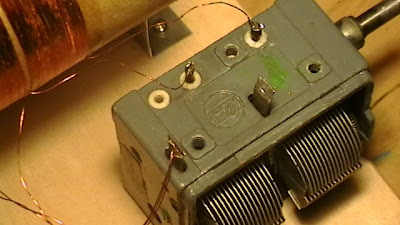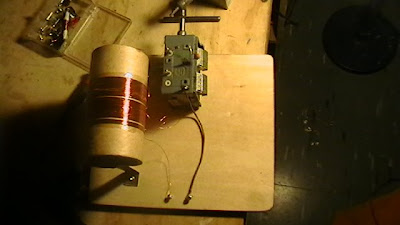
Detector receiver such as a stone was a mineral called Galena (sulfide Lead). Through a process requiring patience and a steady hand, the experimenter achieved by means of a thin wire (cat whisker), touching the surface of this stone, detect the signal from a radio station and hear it through their headset (phones). There is another set of minimal elements all gathered in a way gave the sense of this radio, the Galena was curious element of this issue, and for years, and so far, knows and remembers that name: Radio Galena .
With the forward motion circuit technology has hardly changed, except the size of the items has diminished and the famous Galena Stone was replaced by a glass Germanium, packed in a small glass capsule about 2.5 mm in diameter by about 7 mm in length. So your current name is Cristal Detector. Few use this name and Galena was in the technical vocabulary of the old and young experimenters. Especially
this blog thinking I've built some restless youth, who wants to know how this radio, and highlight the enormous possibilities and hours of entertainment that can provide. What can be done with these elements in regard to the reception of radio stations is awesome. The circuits proposed here have all been studied, constructed and tested by my experience which I shared with friends and amateur experimenters and not a mere copy.
The simplest of these radios is misleading in terms of what we listen and to where we can listen to radio stations. I saw many smiles, almost contemptuous, when I discussed this with some knowledgeable of electronics and the subject of radio reception in particular. Everyone seems to say, "oh yeah! Stages completed. The truth is that few people have understood one Radio to build throughout Galena or crystal detector, and of course as most do not handle other issues such as inductance capacity, etc.. not been able to take advantage of their basic radios.
insist the most senior : Assemble you will smile again and again as the youngest: Electronics is a great source of knowledge and learning. ----------------------------------------------
-------------------------------------------------- -


VARIABLE CONDENSER: The axis moves visible in the picture 180 degrees to a semicircular aluminum plates that move between other boards, also semicircular, that are fixed. The mobile and fixed plates are not touching. There are different types of construction and fixed number of plates MOBILE, but essentially are very similar, except modern ones are usually housed in small plastic containers.

FIXED CAPACITORS CERAMIC : the photo shows "almost" real size several mica or ceramic capacitors fixed. Internally they are constructed so that a small number of very thin foils are separated by other films, through some insulation. They have two connection terminals.
 Old detector Lead sulfide, also known as GALENA . Replaced by the current detector or Germanium Crystal , which is below. (Do not forget that is very small and this is a great extension)
Old detector Lead sulfide, also known as GALENA . Replaced by the current detector or Germanium Crystal , which is below. (Do not forget that is very small and this is a great extension) 
-------------------------------------------- -------------------------------------------------

The amount of electronic symbols is enormous. These are the ones we use for the project.
------------------------------------------------ -----------------------------------------------
A little of my experience and results with these receptors: For many years I built many detectors Cristal, for my own amusement or for some people who are showing incredible interest in these radios. ADVANTAGE cold south and forced the closure I studied what was the heart of these receptors, that is: to know the phenomena and theory of what constitutes the resonant system What is a coil and a capacitor do?
The theory and respective load to determine the frequency of resonansia of these elements will be discussed below, for those not wanting to walk so blindly.
Using only one side of my antenna in a "V" and a bar Coperweil buried in the ground, with the receiver easier, but calculated and rationally constructed during daylight hours listening, covering much of the dial, the local radio station, whose transmitter is hayaba plant located some 500 meters from my receiver (this is called bad selectivity). But once put out (alrrededor 23 hours) Temuco can hear radio stations located about 80 miles north of my place of location. Also with some effort Santiagde Chile auditory stations (Cooperative and Portals). 800 miles! Not bad.
tried with various germanium diodes and things did not improve (listen with less effort) until I started to try different kinds of phones. The change was remarkable. The phones that offered best result was a former crystal earphone. Magnetic headphones are a bit more "hard" (less sensitive). I managed quite comfortably then listen to these radio stations and others. Perceived among the most powerful stations, but could not capture their origin and what they issued. Listen
phones or headset is uncomfortable after a prolonged and ear the limit of their capacity, so I decided to connect my radio to a small amplifier with speaker, the type used in the PC (computer) and then things got more interesting. I managed to hear, of all the mixed signals, radio stations Concepción, Talca, and Argentina (Neuquén)! Then the next step was to build something much more selective ( Selectivity: capacity of a frequency separation circuit of another) and "see" what could be done (Circuit 2).
I know you will relate may seem rather incredible, but some colleagues rightly amateur CA6UKZ CA6UGT and launched the same kind of experience as a receptor to "see" what these Simplesmente things, the same type of antenna and ground and well ... Could be heard clearly
Radios Santiago, Concepción, Talca, Puerto Montt, Neuquén, Rio Black, Mendoza, Cordoba, Buenos Aires. I repeat: CLA-RA-MEN-ET. (With phones or connected to a small amplifier).
The experience must be lived. Enthusiastic reception realistic tests in the bands of 49 meters, 41 meters and 31 meters (short wave) and the results are less interesting.
-------------------------------------------- --------------------------------------------
Circuit 1.

Circuit 2

This is a three-section variable capacitor, as used for circuit 2. It puenden receptors found in old pipes. Cachureos fairs there are elements of this kind or some old radio does not work (cheaper) that we acquire. We get a lot of material for recycling and even build in the future a small radio transmitter, with several components.
------------------------------------------- -------------------------------------------------
circuit modification:

Transformer Volt 220 Volt-6 used in the project. The function of this transformer is to adptar high output impedance of the detector, a low impedance of most modern phones.

The biggest problem when it comes to building these radios is to get some old phones magnetic or glass. To overcome this problem here's a pretty good solution, and is to use a small transformer 220 volt to 6 or 9 or 12volt. The side of the 220V is connected as shown in the circuit and the low voltage side of the phones. (A FACT: The Radio Sport located at Avenida Matta San Diego, in Santiago de Chile sells glass capsules and microphone work perfectly well as headphones. The magnetic phones can be obtained from a fixed network phone, are not ideal but go well). The transformer in the picture is a little big, axisten smaller, but it was I had on hand.
--------------------------------------------- ---------------------------------------------
 Coil Mounting. You can use a small piece of wood as a basis for securing the components (called frame).
Coil Mounting. You can use a small piece of wood as a basis for securing the components (called frame). 

-------------------------------------------- -------------------------------------------------
Interesting Links on these radios:
- Mini Radio Receivers (download PDF file)
- Low-Cost Receivers Beginner
- Experimental Receivers
- Radios you can build
- Radio razor blades (believe it or not)









0 comments:
Post a Comment